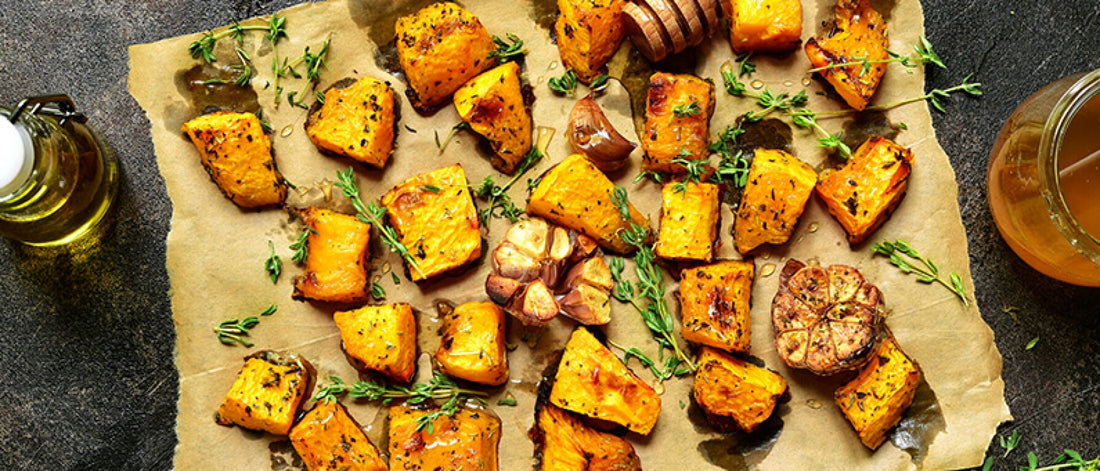Autumn is the season of the harvest—a plentiful time to forage and gather. During the most colorful and abundant season of the year, you may find yourself wanting to cook delicious fall soups and stews. It’s time to savor the applause of nature’s harvest and bounty.
Here are four fall harvest foods—seasonal produce specific to fall—for you to try this season.
How to enjoy: Similar to many other squash varieties, delicata squash is best halved then roasted face down on an oiled baking sheet at 425 degrees for 30 to 40 minutes until nice and tender. Scoop out the seeds and top with sea salt and butter or coconut oil. Stuff with a quinoa pilaf, slice into wedges, or cool and mix into a fall-themed salad.
Don’t let the gnarly and peculiar appearance of celeriac fool you. Celeriac is full of flavor, and a tasty addition to your fall vegetable repertoire. Celeriac is rich in minerals such as potassium and phosphorus, which research shows supports healthy bone density. Celeriac is also full of vitamins C, K, and B6, making it a nutrient-dense choice with many health benefits including fighting free radical damage—diminishing the damage caused to your cells from sources of toxicity and stress—and producing energy.
How to enjoy: Wash and peel well, then roast in the oven in bite-size pieces with a little olive oil and sea salt until lightly crisp (425 degrees for 15 to 20 minutes). Try turning into a variation of mashed potatoes by substituting celeriac in your favorite mashed potato dish or add into your favorite soups and stews for a yummy flavor and texture.
Apple pectin—a type of soluble fiber present in apples—is known to support strong and healthy digestion. Apples are chock full of antioxidants, fiber, and many phytonutrients (naturally produced chemicals that help prevent damage to the foods in which they appear).
When buying apples, buy organic if possible as the Environmental Working Group has listed apples on the “Dirty Dozen” list of most chemically sprayed fruits and vegetables. This will ensure you eat the most healthy and nutrient-dense type of apples on the market.
How to enjoy: The best thing about apples is that you can eat the just as they are—a sweet, tart, and juicy delight. Likewise, apples make a great travel snack paired with nuts or nut butter. Try baking them into a traditional apple pie while substituting sugar with a more natural sweetener such as raw honey, maple syrup, or coconut sugar. Grate apples over your breakfast oats with a dash of cinnamon for a warming fall breakfast. Try juicing your apples with a few vegetables such as celery and ginger, for a soothing fall themed juice.
Named after a city in Belgium where they were first found, Brussels sprouts are especially high in vitamin K, which research is beginning to show contributes to healthy bones. Also, Brussels sprouts are rich with anticarcinogens, aiding in cancer prevention.
How to enjoy: Try them lightly steamed in vegetable broth, sea salt, and pepper. Coat them with some olive oil and a little sea salt and roast until lightly crisp. Or shave them raw into your favorite coleslaw.
The flavors and fare of fall are diverse, dynamic, and easy to fall in love with. Exploring your palate this fall with what you love to eat and cook will attune your body and mind to the season and all its glory.
*Editor’s Note: The information in this article is intended for your educational use only; does not necessarily reflect the opinions of the Chopra Center's Mind-Body Medical Group; and is not a substitute for professional medical advice, diagnosis, or treatment. Always seek the advice of your physician or other qualified health providers with any questions you may have regarding a medical condition and before undertaking any diet, supplement, fitness, or other health program
Want to learn how to stay energetic and balanced all year long? Learn Deepak Chopra’s simple practices to tune into the healing wisdom of nature and thrive, with our self-paced online course, Secrets to Vibrant Health. Learn More.
Here are four fall harvest foods—seasonal produce specific to fall—for you to try this season.
1. Delicata Squash
An heirloom variety of hard-shell squash that is known for its smooth, buttery, and nutty flavor, delicata squash is also low in sugars and high in fiber. Delicata’s unique yellow shell with green stripes makes it easy to recognize alongside its cousins acorn squash, butternut squash, and spaghetti squash. Similar to other hard-shell squashes, delicata squash is high in vitamin C, vitamin A, calcium, and iron. Eat it often for a healthy immune system, strong bones, and as anemia prevention (preventing low levels of iron in your blood, which can leave you feeling weak).How to enjoy: Similar to many other squash varieties, delicata squash is best halved then roasted face down on an oiled baking sheet at 425 degrees for 30 to 40 minutes until nice and tender. Scoop out the seeds and top with sea salt and butter or coconut oil. Stuff with a quinoa pilaf, slice into wedges, or cool and mix into a fall-themed salad.
2. Celeriac
You may know celery as a popular addition to soups, stews, and salads. You may not, however, be as familiar with the form of celery known as celeriac.Don’t let the gnarly and peculiar appearance of celeriac fool you. Celeriac is full of flavor, and a tasty addition to your fall vegetable repertoire. Celeriac is rich in minerals such as potassium and phosphorus, which research shows supports healthy bone density. Celeriac is also full of vitamins C, K, and B6, making it a nutrient-dense choice with many health benefits including fighting free radical damage—diminishing the damage caused to your cells from sources of toxicity and stress—and producing energy.
How to enjoy: Wash and peel well, then roast in the oven in bite-size pieces with a little olive oil and sea salt until lightly crisp (425 degrees for 15 to 20 minutes). Try turning into a variation of mashed potatoes by substituting celeriac in your favorite mashed potato dish or add into your favorite soups and stews for a yummy flavor and texture.
3. Apples
In addition to keeping the doctor away, apples have earned their icon status in the health and wellness field. With an array of health benefits that span maintaining healthy blood sugar levels, cardiovascular health, and cancer prevention, apples are a wonderful fruit to enjoy this fall.Apple pectin—a type of soluble fiber present in apples—is known to support strong and healthy digestion. Apples are chock full of antioxidants, fiber, and many phytonutrients (naturally produced chemicals that help prevent damage to the foods in which they appear).
When buying apples, buy organic if possible as the Environmental Working Group has listed apples on the “Dirty Dozen” list of most chemically sprayed fruits and vegetables. This will ensure you eat the most healthy and nutrient-dense type of apples on the market.
How to enjoy: The best thing about apples is that you can eat the just as they are—a sweet, tart, and juicy delight. Likewise, apples make a great travel snack paired with nuts or nut butter. Try baking them into a traditional apple pie while substituting sugar with a more natural sweetener such as raw honey, maple syrup, or coconut sugar. Grate apples over your breakfast oats with a dash of cinnamon for a warming fall breakfast. Try juicing your apples with a few vegetables such as celery and ginger, for a soothing fall themed juice.
4. Brussels Sprouts
Nothing says fall and the holidays more than a warm roasted pan of Brussels sprouts. Part of the Brassicaceae (or cabbage) family—along with kale, broccoli, radish, and cauliflower—these powerhouse mini cabbages are a cool-weather crop, making them ready just in time for a delicious fall feast.Named after a city in Belgium where they were first found, Brussels sprouts are especially high in vitamin K, which research is beginning to show contributes to healthy bones. Also, Brussels sprouts are rich with anticarcinogens, aiding in cancer prevention.
How to enjoy: Try them lightly steamed in vegetable broth, sea salt, and pepper. Coat them with some olive oil and a little sea salt and roast until lightly crisp. Or shave them raw into your favorite coleslaw.
The flavors and fare of fall are diverse, dynamic, and easy to fall in love with. Exploring your palate this fall with what you love to eat and cook will attune your body and mind to the season and all its glory.
*Editor’s Note: The information in this article is intended for your educational use only; does not necessarily reflect the opinions of the Chopra Center's Mind-Body Medical Group; and is not a substitute for professional medical advice, diagnosis, or treatment. Always seek the advice of your physician or other qualified health providers with any questions you may have regarding a medical condition and before undertaking any diet, supplement, fitness, or other health program
Want to learn how to stay energetic and balanced all year long? Learn Deepak Chopra’s simple practices to tune into the healing wisdom of nature and thrive, with our self-paced online course, Secrets to Vibrant Health. Learn More.






















